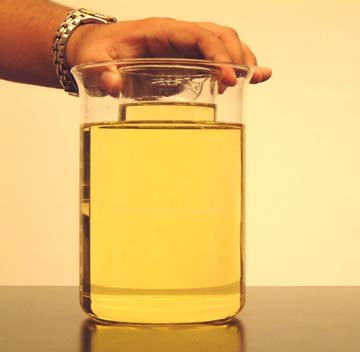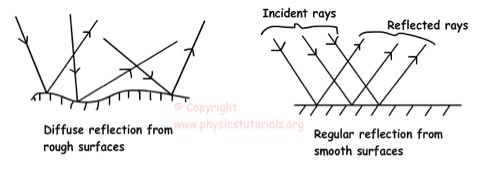Physicist: This is surprisingly subtle!
There are two effects that come into play: the way light reflects off of the surface (surface reflection) and the way light bounces into and then out of the surface (subsurface reflection).
Surface reflection is responsible for the darkening of wet or polished stones. But rather than actually making the surface darker, what polishing or wetting a surface does is “consolidate” the reflecting light into one direction.
If the light hitting a patch of surface is scattered, then you’ll see at least a little of it from any angle. However, if the light only reflects in one direction, then you’re either in the right place to see it or you’re not. So a polished surface looks darker from most angles, but much brighter from just a few angles. The bottom stone in the top picture is a good example.
When a thin film of water is added to a stone it creates a new, second surface above the stone’s actual surface. The surface of the water film reflects in the same way that a polished stone reflects because it’s so smooth. You’re never going to see water with a “sand-paper rough” surface. Water makes stones shiny but dark in the same way that lakes and oceans are shiny but dark.
The interesting colors of stones come, for the most part, from subsurface reflection. That is; light penetrates the surface, wanders around for a little bit, and then pops back out again.
By its nature, subsurface (sometimes called “body”) reflection is a scattering reflection. While polishing will cause all of the surface reflecting light to go in the same direction, there isn’t much you can do to stop subsurface reflection from scattering. Different materials absorb light of different colors, and allow others to pass, so light that undergoes subsurface reflection picks up some colors. Technically; pretty colors.
Surface-reflected light, on the other hand, tends to retain its white, lack of color (here I’m assuming you’re not looking at rocks under a heating lamp or something). So, normally when you look at a rough stone you’ll be seeing the stone’s color, but it will be “drowned out” by the white light being scattered off of the surface. With a polished stone, that white light is being reflected away in one direction, so unless you’re in the path of that white light you’ll just be seeing the more colorful subsurface-reflected light. Polishing doesn’t make a stone more colorful, but it does “turn up the contrast” on the colors already present.

If you’re not in the path of the surface reflected light (white) you’ll only be seeing subsurface reflected light (orange).
In the case of water there’s an added effect. A thin layer of water actually helps light to penetrate the surface of the stone, which increases subsurface reflection, and adds to the color.

When light moves between materials with different indexes of refraction it can either pass through the boundary or reflect. The smaller the difference in indexes, the less light will reflect. Here a glass beaker is held in a fluid with the same index, so zero light is reflected.
Waves (light in particular) travel at different speeds through different materials. This speed is described by the “index of refraction“. When a wave hits the interface between materials with different indexes of refraction it can reflect back. The difference between the the indexes of stone and crystal and the index of air is pretty large and as a result a lot of light will reflect off of the air-to-stone boundary. However, if there’s a layer of water the index steps up twice, from air to water, and again from water to stone. It turns out that a more gradual stepping between indexes allows more light to make it from the air into stone without reflecting.
This additional color from a thin water layer isn’t a dramatic effect, especially compared to the “raised contrast effect” described above, but it’s not zero either.










Thanks heaps for this, your answer covers more than my original question which was about the clarity more than the darkness.
As you say and illustrate, at a microscopic level most rocks are in part transparent and the water causes the light to penetrate further. I now notice that wetting a more opaque surface (like a metal coin or a vinyl record) gives no extra clarity. So that pretty-well proves you must be right.
Pingback: Por que as rochas, quando molhadas, perecem ser mais escuras e brilhantes? by AGREGA LINK – Agregador de Noticias e Informações
Pingback: CG Artist Reference Textures - Gnomon Workshop - Using Photos to Enhance 3D Texture Creation | The Gnomon Workshop News
Pingback: CG Artist Reference Textures - Gnomon Workshop - Using Photos to Enhance 3D Texture Creation | The Gnomon Workshop News
You have confused “its” (belonging to it) and “it’s” (it is).
To Ahhh is… In a more human way of experiencing, percieving and enjoying the accumulation of all manner of life around us daily and momentarily, it may be no more than exposing the wet warmth and richness of colour rather than the clinical colder and sharp agility should such dry stones tumble down a slope, say, that arouses, and our senses salute, that which needs no scientific description. Simply enjoy that which is now!
Pingback: Trout Fishing and the Color of Wet Dubbing - The North American Fly Fishing Forum
My wife and I really loved the write up on dry and wet rocks!! Thank you!
Pingback: 舌頭、石頭,迸出新滋味?科學家為什麼要舔石頭?——2023 搞笑諾貝爾獎 – AI 資訊